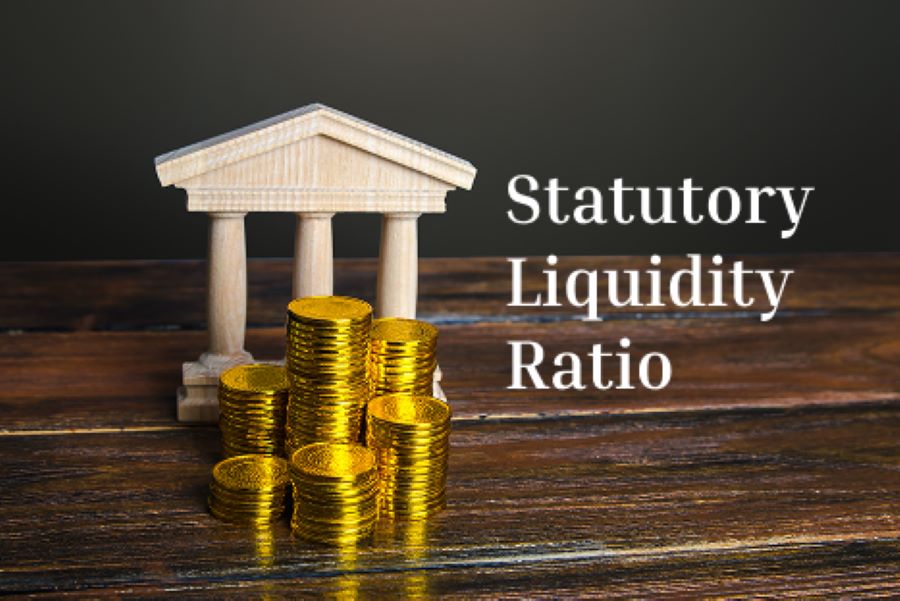Simplifying Life Insurance in India
What is Statutory Liquidity Ratio (SLR) & How to Calculate?

The Full form of "SLR is Statutory Liquidity Ratio." SLR is a minimum percentage of deposits that commercial banks must keep as liquid assets. The Reserve Bank of India can set and change the SLR when necessary.
The Reserve Bank of India maintains various instruments within its monetary policy to administer the Indian economy. It influences commodity prices, cash flow or money supply regulation, and many other economic factors.
The statutory liquidity ratio (SLR) is one financial instrument used by the RBI to maintain banks' solvency.
Read on to learn more about SLR!

Table of Contents

What is the Statutory Liquidity Ratio?
The meaning of statutory liquidity ratio is a mandatory reserve requirement that Indian commercial banks must maintain through liquid assets like cash, gold, bonds, PSU, and RBI-approved securities.
The RBI Act mandates that commercial banks maintain a percentage of their net demand and time liabilities (NDTL) as SLR. RBI determines this percentage of SLR to control a bank's expansion.
A change in this ratio controls financial institutions' ability to inject money into our economy. Therefore, the RBI increases it during inflation to restrict banks and NBFCs from providing loans.
Objectives of Statutory Liquidity Ratio (SLR)
RBI fulfills the following objectives through the statutory liquidity ratio in India:
- SLR controls the bank to oversupply liquid money in the public's hands.
- It controls the money supply and currency flow in our economy.
- It becomes a crucial instrument to tackle both inflation and deflation.
- It ensures the solvency of all financial institutions by improving their monetary supply.
- SLR assists the government's debt management strategies.
- It encourages investments in government securities.
Uses of Statutory Liquidity Ratio (SLR)
The Statutory Liquidity Ratio (SLR) is a monetary policy tool used by the Reserve Bank of India (RBI) to regulate the banking system and the economy. It has many uses, including:
1. Ensuring Bank Solvency
SLR ensures banks have enough liquid assets to cover their liabilities.
2. Controlling Credit Expansion
SLR helps control the amount of credit available to users, which can help curb inflation.
3. Promoting Investment In Government Securities
SLR encourages banks to invest a portion of their deposits in government securities, which helps ensure their solvency.
4. Managing Government Debt
SLR helps the government sell securities with protection and manage its debt.
5. Risk Management
SLR helps banks mitigate the risk of default during financial crises or liquidity shortages.
6. Meeting Seasonal Credit Requirements
SLR helps banks meet their seasonal credit requirements.
7. Keeping Prices Stable
SLR helps stabilize prices, contributing to good economic development.
Components of Statutory Liquidity Ratio (SLR)
1. Liquid Assets
Liquid assets are readily convertible into cash. Gold, cash reserves, government bonds, treasury bills, and RBI-approved securities fall under this category. These include eligible securities under Market Stabilisation Schemes and Market Borrowing Programmes.2. Net Demand and Time Liabilities (NDTL)
A bank holds this aggregate balance of demand and public time deposits. Demand deposits are liabilities a bank must pay on demand, comprising current and savings accounts, demand drafts, etc. In contrast, time liabilities such as fixed deposits do not allow you to withdraw deposits immediately. These have a maturity period before which you cannot access the deposit.How to Calculate Statutory Liquidity Ratio (SLR) with Example?
To calculate the Statutory Liquidity Ratio (SLR), you need to determine the bank's Net Demand and Time Liabilities (NDTL) and apply the required SLR percentage set by the central bank (e.g., the Reserve Bank of India). Here's how to calculate it:
SLR Formula:
SLR=Liquid Assets/Net Demand and Time Liabilities (NDTL)×100
SLR Calculation With an Example:
Suppose a bank has:
- NDTL = ₹500 Crores
- Liquid Assets = ₹150 Crores
- If the required SLR is 18% (as per RBI's requirement), the calculation would be:
SLR = 150/500×100 = 30%
This means the bank maintains 30% of its NDTL in liquid assets, above the required 18% SLR.
What is the Current SLR Rate?
The Statutory Liquidity Ratio (SLR) applicable in India is 18% as of January 29, 2024. This means that commercial banks are required to maintain liquid assets amounting to a minimum of ₹ 18 for every ₹100 deposits held by the bank. This SLR ensures the safety of the banks and lowers the general risk rate.
The Reserve Bank Of India (RBI) determines and regulates SLR, where the SLR ratio can range between 23 and 40%. He can raise the SLR to 40%. All Indian banks must furnish their SLR position to the RBI every 7th day of the week. Any bank that fails to satisfy one SLR requirement is said to suffer a loss or danger from RBI.
Types of Institutions That Need to Maintain an SLR
The following are the institutions for which RBI must maintain a statutory liquidity ratio.
- Scheduled Commercial Banks.
- Non-scheduled Commercial Banks.
- Co-operative Banks (both state and central).
- Urban Co-operative Banks (UCB)
- Small Finance Banks, Payments banks, and Local Area Banks
Impact of Statutory Liquidity Ratio on Investors & Base Rate
Impact of SLR on Investors
The SLR requires that commercial banks invest a percentage of their net demand and time liabilities in liquid assets such as government securities. This directly impacts investors:
- Investment in Government Securities: Given that SLR mandates holding government bonds in the banks' books, this may be a sure demand for the securities, thus benefiting the investors.
- Reduced Investment Flexibility for Banks: The reserve requirement limits banks' flexibility to lend or invest in other high-yield assets. This may affect the overall returns the banks offer and impact the returns to the investors.
- Potential for Lower Returns on Bank Deposits: To comply with SLR, banks invest a portion of their funds in low-yield government securities, which may reduce depositors' returns on deposits and, therefore, affect investment choice.
- Market Liquidity and Yield Curve: If SLR increases, forcing banks to hold government securities may significantly negatively influence the yield curve and market liquidity. Long-term investors in government bonds would benefit from a stable SLR.
Impact of SLR on Base Rate
The base rate is the rate a commercial bank lends to its customers. The following are the effects of the SLR on the base rate:
- Cost of Funds to Banks: Banks must hold a higher portion of their assets in liquid cash forms, such as government bonds, which yield less income than other forms of investment.
- Credit Supply and Interest Rate: A high SLR limits the bank's lending capacity, hence the supply of credit available in the economy. Therefore, the banks' base rates may increase to check the loan demand and keep their profitability intact.
- Link with Inflation Control: Central banks manipulate SLR to control inflation. It is generally true that a higher SLR brings with it a higher base rate, and holding up operational costs, banks pass on this cost to consumers.
Reasons for Reduction in Statutory Liquidity Ratio by RBI
The Reserve Bank of India (RBI) occasionally reduces the Statutory Liquidity Ratio (SLR) to stimulate economic growth and ensure better liquidity in the banking system. Here are several key reasons for reductions:
1. Boosting Credit Flow
The reduction in SLR allows banks to hold fewer reserves in liquid assets, thereby allowing them to lend more to businesses and individuals. This would, therefore, support economic growth, especially during an economic slowdown or low demand.
2. Improving Liquidity in the Market
Low SLR increases cash availability in the banking system by supporting the immediate need for short-term liquidity. This boosts economic performance mainly during periods of stagnant inflation and low demand since cash ensures the economy has enough in circulation.
3. Encouraging Investment
Lower SLR requirements make banks invest in more productive assets, such as loans given to industries and businesses, rather than tying up the funds in low-yield government securities. This helps increase economic growth by channeling resources into sectors with high returns.
4. Controlling Inflation
In case inflation is controlled, reducing SLR will help banks better manage their liquidity without letting it go into excess money supply, which otherwise may force inflationary pressures. More room for lending may be given by the RBI while keeping price stability.
5. Supporting Growth in Government Borrowing
Lower SLR requirements can boost demand for other investment forms, which could help the government's borrowing needs if funds shift to other areas. This helps the government meet its borrowing requirements efficiently and supports fiscal policies.
6. Encouraging Bank Lending and Investment in Other Sectors
Banks with fewer reserves have more capital to invest in infrastructure and housing, among other high-growth investment areas. With higher availability of funds for such investment, the reduction in SLR promotes economic expansion.
What Happens if Banks do Not Maintain Statutory Liquidity Ratio?
Statutory Liquidity Ratio (SLR) vs Cash Reserve Ratio (CRR)
The SLR and CRR are two essential monetary tools that commercial banks use to regulate the financial system. They serve different purposes. Here are the key differences between them:
Banks worldwide are institutions that securely hold public deposits and offer returns. Nevertheless, this function is risky and requires every bank to be cautious. RBI justifies the policy of statutory liquidity ratio by ensuring banks' solvency and protecting the public's money.
Disclaimer: The information provided on this website is for general informational purposes only and should not be construed as financial, investment, or legal advice. While we strive to provide accurate and up-to-date content, we do not guarantee the completeness, reliability, or suitability of the information for your specific needs.
We do not promote or endorse any financial product or service mentioned in these articles. Readers are advised to conduct their own research, consult with financial experts, and make informed decisions based on their unique financial circumstances. Any reliance you place on the information provided here is strictly at your own risk.
FAQs about Statutory Liquidity Ratio
What is the statutory liquidity ratio?
What is the current SLR rate?
What is the impact of SLR on the base rate?
What will SLR do to an Investor?
Who decides SLR?
Which institutions are required to maintain SLR?
What is the purpose of SLR?
How does the SLR work?
Are SLR and CRR the same?
What happens if banks don't maintain SLR?
Do NBFCs in India need to maintain SLR?
How is SLR in India calculated?
What happens if SLR increases?
What is the full form of SLR?
Other Important Articles about Mutual Funds
Disclaimer
- This is an informative article provided on 'as is' basis for awareness purpose only and not intended as a professional advice. The content of the article is derived from various open sources across the Internet. Digit Life Insurance is not promoting or recommending any aspect in the article or its correctness. Please verify the information and your requirement before taking any decisions.
- All the figures reflected in the article are for illustrative purposes. The premium for Coverage that one buys depends on various factors including customer requirements, eligibility, age, demography, insurance provider, product, coverage amount, term and other factors
- Tax Benefits, if applicable depend on the Tax Regime opted by the individual and the applicable tax provision. Please consult your Tax consultant before making any decision.
Latest News
Read More
















